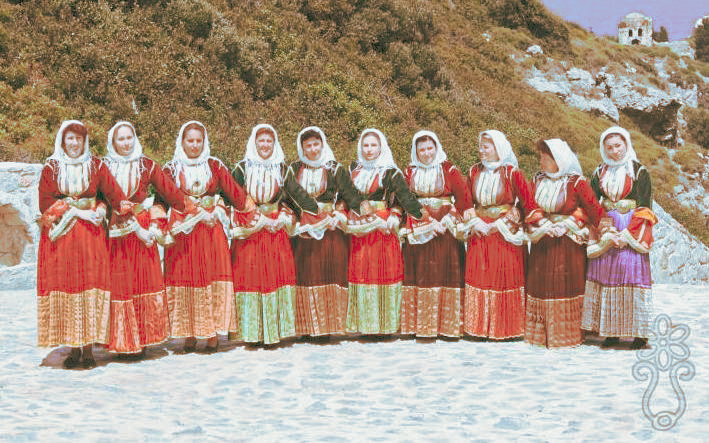Costumes and Traditions
Nowadays, Skiathos Island has significantly evolved, with five-star hotels, modern facilities and visitors from all over the world. Yet, it still remains one of Greece’s islands that have managed to preserve many of their customs and traditions throughout the centuries. Let’s take a quick look at Skiathos’ most renowned traditions:
Kamara
A local, dancing song performed, solely, by women dressed in the island’s official costume. “Kamara”, or else, “St.George’s song”, is danced according to St.George’s traditional dancing movements after the Second Resurrection and during St.George’s celebration day. Women “knit” their hands together and dance in a cyclical pattern, being almost merged with each other.
Skiathos’ Traditional Costume
You will be surprised to learn that locals used to wear their traditional costumes every day! The men’s clothing consisted of a bloomer and a “fesi” (: a traditional type of hat) with a long bobble on it. However, after the Revolution of 1821, men gradually started to replace the bloomers with trousers. Thus, we could say that the era of Skiathos’ traditional costume for men ended somewhere around 1960s, when the very last local who wore a bloomer passed away.
As regards the women’s traditional attire, it still exists and is chosen by many local women for national celebrations, parades and festivals. It goes without saying that women’s costumes were by far more precious and astounding than men’s, which is why more pieces have still been preserved. Their official costume includes: a shirt, an undershirt, shocks, a small piece of fur made by felt, a gilet made of velvet fabric and embellished with beautiful decorative details, a petticoat, an inner dress made of wool, a golden belt, a silk scarf and one large woolen fringed scarf –which they wore, mainly, during the winter. In addition, the outfit’s magnitude was further enhanced by various pieces of jewelry such as big earrings with florins, bracelets, rings, pins and one pendant with a golden chain and golden florins.
Skiathos’ cuisine – Local products
Skiathos’ cuisine is rather outstanding, as it consists of extraordinary delicacies (most of which are based on seafood), as well as many traditional pies and exceptional sweets! Apart from Skiathos’ unique food recipes, though, there is a variety of local products, too, such as: honey, jams, olive oil, tsipouro (a famous Greek type of alcohol) and, of course, premium wines and liqueurs like the well-known ‘Alipiakos Wine’ (produced at the Holy Monastery of Evaggelistria). This remarkable wine has taken its name from the monk Alipios (the Greek name means “without sorrow”). Some of the island’s delicious sweets are:
“Xamalia”: This type of sweets was, traditionally, served at wedding feasts. Their triangular shape resembled a “love charm”, designed to protect and spread joy among the newlyweds. Additionally, they were filled with honey and walnut, ingredients that, according to folklore, aided the couple in having children. The crust is handmade and fried in premium local olive oil. Finally, the sweets are served with a sprinkling of castor sugar.
“Amigdalota”: Another delicious, traditional delicacy! These sweets are cooked with white almond kernel, which the locals knead with sugar and flower water. They are lightly baked and their shape reminds us of a small lily. As soon as the baking is over, the sweets are sprinkled with flower water and castor sugar. The special occasions for this type of sweets are, mostly, baptisms and name days.
“Aspro (White)”: This exquisite sweet is, in fact, a delicious jam that was served -and is still served- on engagements. The jam is cooked with slightly-cut, white almond kernel, sugar syrup and lemon. Here is the hidden message from this sweet to the newlyweds: the stronger the ingredients’ bond, the stronger the couple’s bond! The jam is served in large pots and each guest serves themselves using a spoon.
The Holy Thursday’s Carols
On Holy Thursday, the island’s children, after having attended the church and taken communion, they wander around, from door to door, singing the Holy Thursday’s carols. They hold crosses made of reed, which are adorned with rosemary, violets, roses, lilies and poppies.
The Agioritiko Custom of Good Friday
For Skiathos Island, Good Friday is a day of grief and mourning. On this day, according to tradition, locals refuse to eat anything and never shake hands when meeting at the street. As regards the procession of the bier of Christ, locals follow the ‘Agioritiko’ custom: the religious ceremony starts at one o’clock after midnight, while the procession begins at four o’clock in the morning. In an emotional and reverential atmosphere, the litany passes through every cobbled-street of the town, in between the illuminated houses. After the litany arrives back to the church, around 5:30 in the morning, all people stand in front of the church’s closed door and wait for the traditional representation of the Descent of Christ into Hell, while the priest shouts “Open the Gates!” (“Arate Pilas!”)
Festivals
One of the biggest celebrations of Skiathos Island is the ‘Holy Mary’s Epitaph’, which takes place on the 15th of August, in Evaggelistria Monastery. Thousands of worshippers are flocking the entire island every year to attend this one-of-a-kind event, which begins on the eve of the feast, with the ‘Exodus of the bier of Holy Mary’. All locals are profoundly emotional and in a high reverential state, as they chant the Praises of Virgin Mary. Nevertheless, apart from this exceptional occasion, there are many more special Saints’ name days that trigger locals into hosting various memorable festivals. One of these takes place on the 21st of November, at Panagia Kounistra (“Holy Mary Kounistra”), the patron saint of the island. On this day, locals carry -by feet- the saint’s icon from the Metropolitan temple of the Three Saints to the exact place where it was found. Then, they arrive at the patron saint’s monastery where they have a wake. Ultimately, the icon returns, with honors, back to the town of Skiathos on the same day of the celebration.


